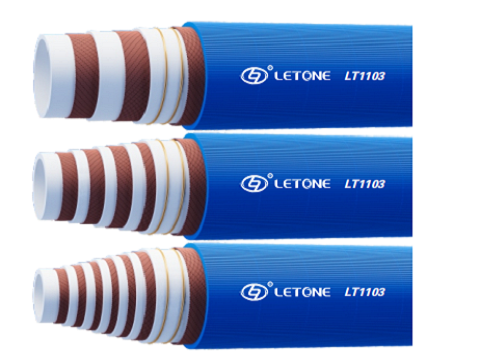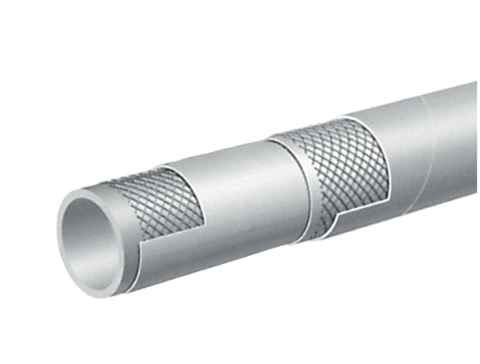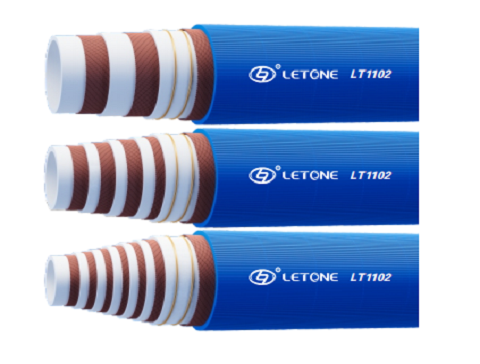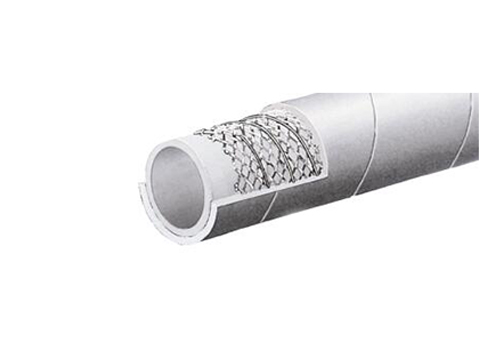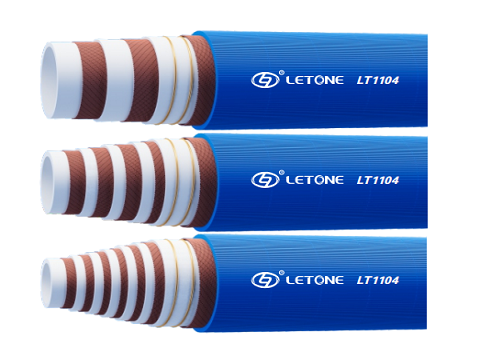Dry powder conveying hose is a special pipeline system mainly used for conveying dry powder materials. Due to its high efficiency, safety, and hygiene, it has been widely used in fields such as food, pharmaceuticals, and chemicals. This article will provide a detailed introduction to the characteristics, applications, and selection suggestions of dry powder conveying hoses.
1、 The characteristics of dry powder conveying hoses
1. Efficiency: The dry powder conveying hose adopts advanced design and materials, which can quickly and efficiently transport dry powder materials, improving production efficiency.
2. Safety: The dry powder conveying hose has good wear resistance and pressure resistance, which can effectively avoid material leakage and pipeline rupture, ensuring production safety.
3. Environmental friendliness: The dry powder conveying hose adopts a closed conveying method, which can effectively reduce material scattering and dust flying, and reduce environmental pollution.
4. Hygiene: The dry powder conveying hose has good cleaning and disinfection performance, which can effectively ensure the hygiene quality of materials and meet the production requirements of industries such as food and pharmaceuticals.
2、 The application of dry powder conveying hoses
1. Food industry: Dry powder conveying hoses are widely used in the food industry, such as conveying materials such as flour, milk powder, seasonings, etc. It can effectively ensure the hygiene and quality of food, and improve production efficiency.
2. Pharmaceutical industry: In the pharmaceutical industry, dry powder conveying hoses are used to transport powdered materials such as pharmaceutical raw materials and intermediates. It can effectively ensure the hygiene and quality of drugs, and improve production efficiency.
3. Chemical industry: In the chemical industry, dry powder conveying hoses are used to transport various chemical raw materials, catalysts, and other powdered materials. Can effectively ensure the stability and safety of chemical reactions.
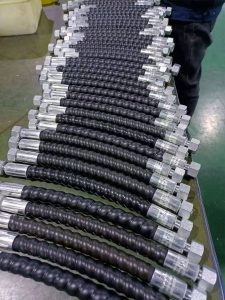 3、 Suggestion for selecting dry powder conveying hoses
1. Understanding material characteristics: When selecting a dry powder conveying hose, it is necessary to understand the characteristics of the material, such as particle size, density, viscosity, etc., in order to choose suitable pipes and specifications.
2. Consider the length of the pipeline and the number of bends: The length of the pipeline and the number of bends will affect the fluidity and conveying efficiency of the material. On the premise of meeting the process requirements, the length of pipelines and the number of elbows should be minimized as much as possible.
3. Consider the support and fixation of pipelines: In order to prevent vibration and displacement of pipelines, it is necessary to design support and fixation devices reasonably. Meanwhile, for the convenience of maintenance and replacement, a structural design that is easy to disassemble and install should be adopted as much as possible.
4. Consider the connection method of the pipeline: The connection method of the dry powder conveying hose should be sealed reliably and not prone to leakage. Common connection methods include flange connection, clamp connection, etc. The appropriate connection method can be selected according to the actual situation.
5. Consider pipeline materials and anti-corrosion measures: Select appropriate pipeline materials and anti-corrosion measures based on the characteristics of the materials and the usage environment. Common pipeline materials include stainless steel, polyethylene, etc. Suitable materials and anti-corrosion measures can be selected according to the actual situation.
6. Consider cleaning and disinfection of pipelines: In order to ensure the hygiene quality of materials, it is necessary to regularly clean and disinfect pipelines. Therefore, when choosing a dry powder conveying hose, a structural design that is easy to clean and disinfect should be chosen.
7. Consider the production capacity of pipelines: When selecting dry powder conveying hoses, consideration should be given to whether their production capacity meets actual needs. While ensuring production capacity, it is also necessary to consider whether it meets process requirements and economic principles.
8. Reference to relevant standards and specifications: When selecting dry powder conveying hoses, relevant standards and specifications should be referred to to ensure that the selected pipeline meets relevant requirements and regulations. At the same time, attention should also be paid to the quality and reliability of pipelines to avoid safety accidents and quality issues.
In summary, selecting a suitable dry powder conveying hose requires consideration of multiple factors, including material characteristics, pipeline length and number of bends, support and fixation methods, connection methods, pipeline materials and anti-corrosion measures, cleaning and disinfection requirements, and production capacity. In specific applications, comprehensive consideration should be given to the actual situation and appropriate dry powder conveying hoses should be selected to ensure smooth production. At the same time, it is necessary to strengthen the maintenance and management of pipelines, regularly inspect the working status and wear of pipelines, promptly address problems and hidden dangers, and ensure the safety and stability of production.
3、 Suggestion for selecting dry powder conveying hoses
1. Understanding material characteristics: When selecting a dry powder conveying hose, it is necessary to understand the characteristics of the material, such as particle size, density, viscosity, etc., in order to choose suitable pipes and specifications.
2. Consider the length of the pipeline and the number of bends: The length of the pipeline and the number of bends will affect the fluidity and conveying efficiency of the material. On the premise of meeting the process requirements, the length of pipelines and the number of elbows should be minimized as much as possible.
3. Consider the support and fixation of pipelines: In order to prevent vibration and displacement of pipelines, it is necessary to design support and fixation devices reasonably. Meanwhile, for the convenience of maintenance and replacement, a structural design that is easy to disassemble and install should be adopted as much as possible.
4. Consider the connection method of the pipeline: The connection method of the dry powder conveying hose should be sealed reliably and not prone to leakage. Common connection methods include flange connection, clamp connection, etc. The appropriate connection method can be selected according to the actual situation.
5. Consider pipeline materials and anti-corrosion measures: Select appropriate pipeline materials and anti-corrosion measures based on the characteristics of the materials and the usage environment. Common pipeline materials include stainless steel, polyethylene, etc. Suitable materials and anti-corrosion measures can be selected according to the actual situation.
6. Consider cleaning and disinfection of pipelines: In order to ensure the hygiene quality of materials, it is necessary to regularly clean and disinfect pipelines. Therefore, when choosing a dry powder conveying hose, a structural design that is easy to clean and disinfect should be chosen.
7. Consider the production capacity of pipelines: When selecting dry powder conveying hoses, consideration should be given to whether their production capacity meets actual needs. While ensuring production capacity, it is also necessary to consider whether it meets process requirements and economic principles.
8. Reference to relevant standards and specifications: When selecting dry powder conveying hoses, relevant standards and specifications should be referred to to ensure that the selected pipeline meets relevant requirements and regulations. At the same time, attention should also be paid to the quality and reliability of pipelines to avoid safety accidents and quality issues.
In summary, selecting a suitable dry powder conveying hose requires consideration of multiple factors, including material characteristics, pipeline length and number of bends, support and fixation methods, connection methods, pipeline materials and anti-corrosion measures, cleaning and disinfection requirements, and production capacity. In specific applications, comprehensive consideration should be given to the actual situation and appropriate dry powder conveying hoses should be selected to ensure smooth production. At the same time, it is necessary to strengthen the maintenance and management of pipelines, regularly inspect the working status and wear of pipelines, promptly address problems and hidden dangers, and ensure the safety and stability of production.

